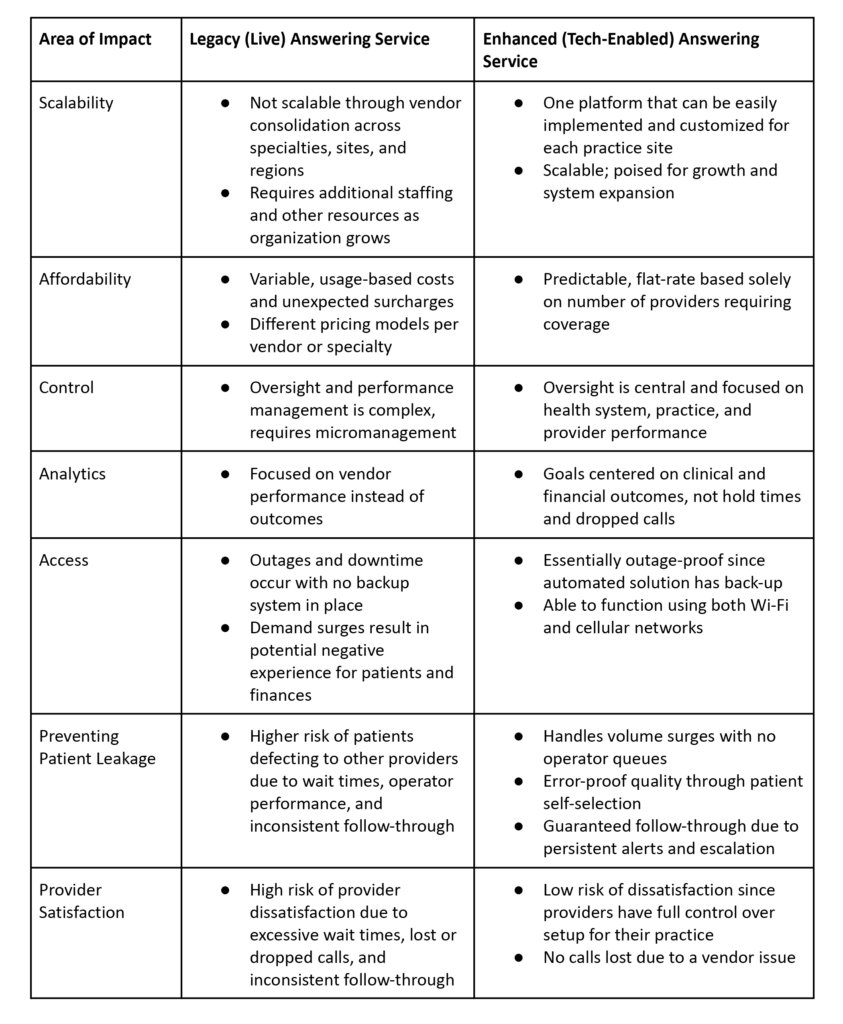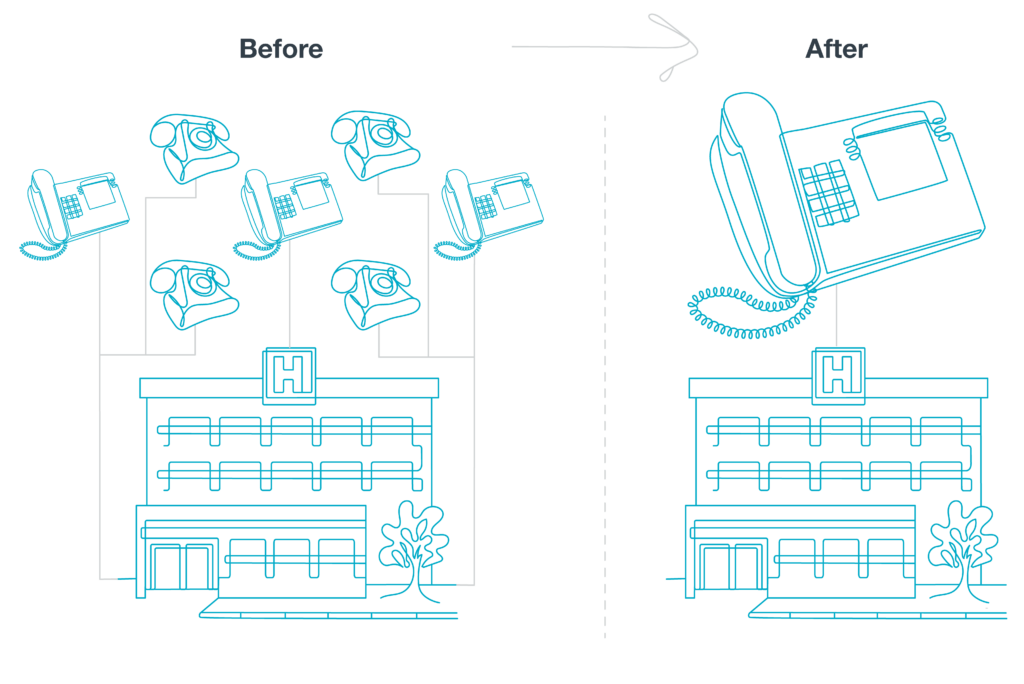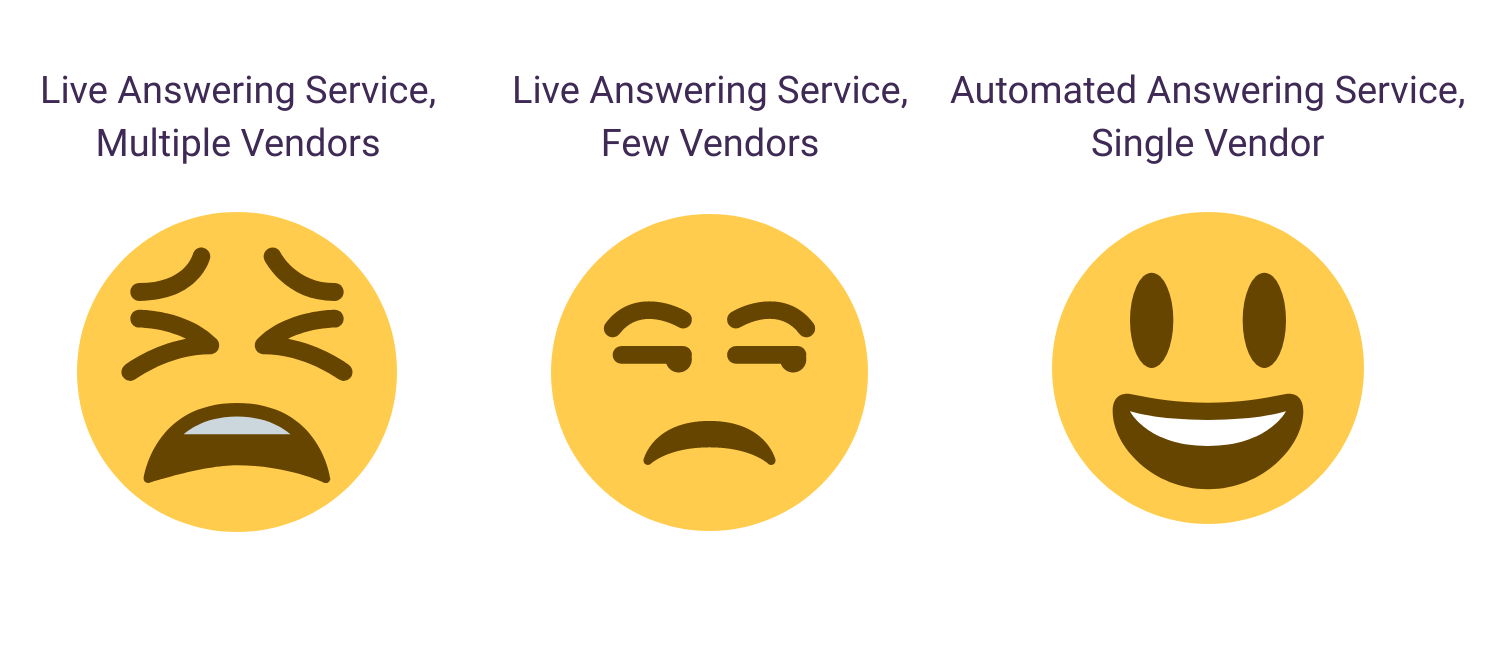Live Session
A Roadmap for Change Management Projects
Register NowTABLE OF CONTENTS

We recently took a deep dive into how the typical health system perspective of the medical answering service limits its potential. The answering service has long been viewed as a basic cost of doing business—something health systems pay for mostly to avoid catastrophic outcomes. Rarely do operations leaders consider how it can become a vehicle for better communication, better clinical workflows, and better experiences for patients and providers alike.
Answering service technology has evolved significantly, and it can be deployed quickly and easily across an entire health system’s employed (and affiliated) medical practices. As clinical services writ large have embraced technology and its advantages, it’s been decades since significant changes have been made to the way after-hours patient calls are managed. It’s long past time for an update.
Working with clients over the past ten years, we’ve also seen tremendous growth in the size and scope of employed and integrated medical groups. Among new clients, we’ve noticed three common structures for medical group answering services:
As we continue to examine the merits of modernizing the answering service, this post focuses on realizing enterprise, system-level benefits with the third structure. Let’s look at how this solution can become a strategic asset that is simultaneously more affordable, flexible, and capable than what many health systems use today.

Scalability
Traditional, live-operator answering services are simply not very scalable. If a health system is faced with a mishmash of vendors inherited through practice acquisitions made over time, it can be a tangled web to navigate. Scaling in this environment is nearly impossible. Is it possible for one vendor to support all of your sites, or are you relegated to a multi-vendor approach that siloes communication and adds complexity?
And even if the health system is fortunate enough to depend on just one or two answering service vendors, scalability remains limited.. Adding new practice sites into the fold may require that both the health system and vendors dedicate additional staff or resources to invest in building each practice’s after-hours workflows, training operators on new workflows, and monitoring performance.
On the other hand, a cloud-based, automated answering service solution is endlessly scalable. Best practice workflow starter sets mean that end-to-end setup, optimization, and training take just a few days. New providers and care team members can also be added to existing workflows and on-call schedules with ease. Scalability like this is key to future-proofing your system’s clinical operations because more efficient implementation is the only way to keep up with the pace of mergers and acquisitions. Having one consistent and customizable platform sets up the framework for medical practice growth and expansion.
Affordability
Traditional medical answering services use live agents and usually come with variable (or per-use) costs. When a health system uses multiple vendors across practice locations, these pricing models are often different and fluctuate based on demand and specialty. This means costs are both inconsistent and unpredictable. For health systems with just a couple of vendors, costs still vary substantially month to month and can skyrocket in a crisis–not unlike an old long-distance phone bill. If your health system experiences an influx of calls due to unforeseen circumstances—say, a public health or environmental crisis—your answering service bill is likely to reflect that volume increase.
The tech-enabled answering service is an automated, fixed-rate solution that gives you a consistent and predictable cost based on the number of providers requiring coverage rather than the volume of calls being received. This can turn into an opportunity for sizable cost savings, as demonstrated by the implementation PerfectServe did for New York City-based Hospital for Special Surgery (HSS). With 3,500 users spread across 175 clinic locations, effective communication—especially after hours—wasn’t always easy for HSS. After switching to PerfectServe, HSS moved from seven different answering services to one unified platform that automated workflows, eliminated human error, and increased speed to treatment. Most notably, HSS was able to eliminate a $3,000-per-physician fee for their previous answering service, which resulted in a total cost savings of approximately $600,000 per year.

Control
With traditional answering services, quality control is difficult—there’s only so much you can do to control the operators and services that don’t work for you directly. It’s also hard to effect meaningful change based on a report that’s received a week or a month after an incident. If shortcomings can’t be addressed in real time, the likelihood of recurrence is higher, which puts patient and provider satisfaction at risk.
With an automated solution, control is built in from the start. System workflows and prompts can be tailored to the needs of each practice, and they can be edited on demand as needed. Real-time performance data for things like response times and escalations is readily available, and the health system can ultimately track the outcome of every call. That’s the key here—no process or metric is out of the health system’s hands.
Analytics
With any system that supports care delivery and coordination, relevant analytics are a powerful tool that can be used to make targeted process improvements. As such, medical answering services should offer detailed analytics reports that allow communication metrics to be evaluated to uncover weak spots and vulnerabilities. Traditional answering services are data poor and may only offer metrics focused on vendor performance—say, average wait time per agent or number of calls answered per agent per hour. These metrics are also not likely to be clearly aligned with any health system’s broader goals surrounding quality of patient care.
An enhanced answering service allows administrators to quickly view and analyze real-time communication data for practices across the system to create more efficient workflows. For example, when Dr. Smith is on call and a patient phones in with an urgent issue, how long does it usually take him to answer or return their call? If that average is suboptimal, how can different variables be shifted—including things like schedules or specific communication workflows—to create better outcomes for the patient? Data like this is centrally managed and easily accessible, and it’s no longer focused solely on vendor performance. It can be analyzed as often as necessary to make sure your practices are optimally serving patients and supporting providers.
Consistent Access
No matter the vendor, the word “downtime” has frightening connotations in the world of healthcare. For something like your answering service, downtime can easily bring about real-world consequences. If patients are used to having after-hours access to on-call providers at your clinics when serious issues arise, what happens when that line of communication simply stops working?
Let’s say a serious storm knocks the power out at the building where the live agents work. If a patient calls during that outage and gets radio silence, they may end up taking an unnecessary trip to one of your system’s emergency rooms if their level of concern is high enough. Or, maybe they decide to wait it out until the next morning, even though an immediate trip to the emergency room actually is warranted. Neither is a good outcome.
A modern, cloud-based answering service, on the other hand, is essentially outage-proof thanks to its technical infrastructure and ability to utilize both Wi-Fi and cellular networks. Even in the above power outage scenario, your clinics would still be able to take patient calls and otherwise route urgent messages appropriately. In the event that one clinic is completely out of commission—maybe due to a local evacuation caused by a natural disaster—a cloud-based solution can easily route all incoming calls and messages to other personnel within your system. No matter the circumstances, the “always on” nature of a tech-enabled answering service means your patients will always be able to access your services when needed.
Preventing Patient Leakage
Traditional answering services can contribute to high dissatisfaction rates—and increased risk of patients defecting to another provider—for a number of reasons, including excessive call wait times, poor operator performance, and inconsistent follow-through on patient inquiries. If you’re dealing with multiple vendors, controlling the quality and reliability of these interactions becomes even harder.
These negative experiences cause stress and frustration for patients, which can often be the impetus for finding a new provider. An automated answering service solution that uses intelligent routing to direct communication makes quality control much easier because:
Patients with a consistently positive call-in experience are less likely to seek care elsewhere. Viewed through this lens, a medical answering service can actually protect revenue by boosting the patient experience and cutting down on patient leakage.
Provider Satisfaction
Not to be forgotten on this list is another all-important consideration: provider satisfaction. Legacy answering services bring with them a much higher risk of contributing to provider dissatisfaction due to things like lost or dropped calls, inconsistent follow-through, and excessive wait times. Providers want to be a source of timely, efficient, and high-quality care for their patients, and they naturally become frustrated when the resources at their disposal make that impossible. Providers hear patient complaints, and whether the result is lost patients or lower patient satisfaction ratings, it’s a major drag on morale and risks revenue.
Switching to enhanced answering service technology significantly lowers the risk of provider dissatisfaction because—with the right vendor—they have full control over how the system is set up for their practice. They can game out as many scenarios as they see fit, and the workflows for each can be hardwired into the system from the start. Additionally, because of the reliability of a cloud-based solution, providers no longer have to worry about lost calls stemming from vendor issues.

With more than 25 years of experience building clinical workflows under our belt, PerfectServe understands the unique communication needs of large and small health systems alike. If you’ve thought about a communication workflow, we’ve probably implemented it. If we haven’t, we’re always ready to learn.
Our medical answering service solution brings all of the above benefits—scalability, affordability, central control, rich analytics, consistent patient access, less patient leakage, and improved provider satisfaction—to your table. We’re confident that, by implementing an answering service solution that utilizes the latest in communication technology, you’ll find a number of downstream outcomes that never would have been possible with the “answering service as cost center” perspective.
Contact us today to learn more while you wait for the next blog in this series, which will detail how this enterprise answering service strategy is beneficial to patients.
Already a PerfectServe customer? Learn how to use PerfectServe’s Practice Communication solution at every site within your health system.